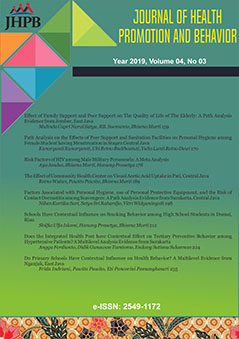Path Analysis on the Effects of Peer Support and Sanitation Facilities on Personal Hygiene among Female Student having Menstruation in Sragen Central Java
Abstract
Background: Poor personal hygiene during menstruation causes the risk of Reproductive Tract Infection (RTI) in adolescent. It threatens women's health. Personal hygiene is affected by attitude, peer support, and the availability of personal hygiene facilities. This study aims to analyze the determinant of personal hygiene in adolescents during menstruation in Sragen Regency, Central Java.
Subjects and Method: This study was an analytic observational study with a cross sectional design. The study was conducted in June 2019. A sample of 200 study subjects was selected for this study by simple random sampling. The dependent variable was personal hygiene. The independent variables were attitude, peer support, and the availability of personal hygiene facilities. The study was collected by questionnaire and analyzed by path analysis.
Results: Personal hygiene was directly and positively affected by positive attitude (b=1.38; 95% CI=0.78 to 1.98; p<0.001). Personal hygiene was indirectly affected by strong peer support and the availability of good personal hygiene facility.
Conclussion: Personal hygiene is directly and positively affected by positive attitude. Personal hygiene is indirectly affected by strong peer support and the availability of good personal hygiene facility.
Keywords: personal hygiene, attitude, peer support, personal hygiene facilities
Correspondence:
Kunaryanti. Masters Program in Public Health, Universitas Sebelas Maret, Jl. Ir. Sutami 36A, Surakarta 57126, Central Java. Email: kunaryanti@yahoo.com. Mobile: +6285700900029.
Journal of Health Promotion and Behavior (2019), 4(3): 170-177
https://doi.org/10.26911/thejhpb.2019.04.03.02
How to Cite
References
Anand E, Singh J, Unisa S (2015). Menstrual hygiene practices and its association with reproductive tract infections and abnormal vaginal discharge among women in India. Sexual Reproductive Healthcare, 6 (2015) 249–254 Retrieved from http://dx.doi.org/10.1016/j.srhc.2015.06.001
Alam MU, Luby SP, Halder AK, Islam K, Opel A, Shoab AK et al (2016). Menstrual hygiene management among Bangladeshi adolescent schoolgirls and risk factors affecting school absence: results from a crosssectional survey. BMJ Open, 7: e015508. doi: 10.1136/bmjopen-2016-015508.
Das P, Baker KK, Dutta A, Swain T, Sahoo S, Das BS, Mishra PR (2015). Menstrual hygiene practices, WASH access and the risk of urogenital infection in women from Odisha, India. PloS ONE, 10(6), e0130777. Retrieved from https://doi.org/10.1371/journal.pone.0130777.
Deshpande TN, Patil SS, Gharai SB, Patil SR, Durgawale PM (2018). Menstrual hygiene among adolescent girls A study from slum area. J Family Med Prim Care. 7(6): 1439–1445. doi: 10.4103/jfmpc.jfmpc_80_18.
Eijk AM, Sivakami M, Thakkar MB, Bauman A, Laserson KF, Coates S et al (2016). Menstrual hygiene management among adolescent girls in India: asystematic review and meta-analysis. BMJ Open, 6:e010290. doi:10.1136/bmjopen-2015-010290.
Eslamimehr F, Rakhshani F, Ramezan Khani A, Khodakarim S (2017). The examination of the effectiveness of an educational intervention based on the Planned Behavior Theory on improving pubertal health behavior in female high school students. Int J Pediatri,
(9): 5643-5654. doi: 10.22038/ijp.2017.24027.2028.
Fehintola FO, Fehintola AO, Aremu AO, Idowu A, Ogunlaja OA, Ogunlaja I P (2017). Assessment of knowledge, attitude and practice about menstruation and menstrual hygiene among secondary high school girls in Ogbomoso, Oyo state, Nigeria. Int J Reprod Contracept Obstet Gynecol, 6(5): 1726-1732. Retrieved from http://dx.doi.org/10.18203/2320-1770.ijrcog20171932
Geethu C, Paul EP, Thomas JE, Pullan CS, Hemalatha S, Sivakumar T (2017). Appraisal of menstrual hygiene management among women in a rural setting: a prospective study. Int J Community Med Public Health, 3(8): 2191-2196. Retrieved from http://dx.doi.org/10.18203/23946040.ijcmph20162569
Nasir S, Murti B, Suryani N (2016). Path analysis on the association between predisposing, enabling, and forcing factors, and house sanitation in Bengkulu, Sumatera. J Health Promot Behav, 1(3): 190-200 Retrieved from https://doi.org/10.26911/thejhpb.2016.01.03.06.
Nuraini A, Ronoatmodjo S (2018). The effectiveness of comic as learning media to enhanceknowledge of menarche and menstruation among female students in Yogyakarta. J Health Promot Behav, 3(4): 257-262. Retrieved from https://doi.org/10.26911/thejhpb.2018.03.04.05.
Putri A, Joebagio H, Indarto D (2017). Community Participation in sanitation program, Surakarta. J Health Promot Behav, 2(3): 257-271. Retrieved from https://doi.org/thejhpb.2016.02.03.06.
Sulaeman S (2016). Pembelajaran model dan teori perilaku kesehatan konsep dan aplikasi. Surakarta: UNS Press.
Sumpter C, Torondel B (2013). A systematic review of the health and social effects of menstrual hygiene management. PloS ONE, 8(4), e62004. Retrieved from https://doi.org/10.1371/journal.pone.0062004.
Sivakami M, Eijk AM, Thakur H, Kakade N, Patil C, Shinde S, et al. (2019). Effect of menstruation on girls and their schooling, and facilitators of menstrual hygiene management in schools: surveys in Government Schools in Three States in India, 2015. J Glob Health, 9 (1): 010408. doi: 10.7189/jogh.09.010408
Thakre SB, Thakre SS, Reddy M, Rathi N, Pathak K, Ughade S (2011). Menstrual hygiene: knowledge and practice among adolescent school girls of Saoner, Nagpur district. Journal of clinical and diagnostic Research, 5(5): 1027-1033. Retrieved from http://dx.doi.org/10.1155/2016/1056235
Tiwari A, Ekka IJ, Thakur R (2018). Assessment of knowledge and practices regarding menstrual hygiene among adolescent girls of Government higher secondary school, station Murhipar, Rajnandgaon (CG). Int J Community Med Public Health, 5(4), 1335-1338. Retrieved from http://dx.doi.org/10.18203/23946040.ijcmph20180973
Triwibowo C, Pusphandani M (2015). Pengantar dasar ilmu kesehatan masyarakat. Yogyakarta: Nuha Medika.
Upashe SP, Tekelab T, Mekonnen J (2015). Assessment of knowledge and practice of menstrual hygiene among high school girls in Western Ethiopia. BMC women's health, 15(1), 84. Retrieved from https://doi.org/10.1186/s12905-015-0245-7.
Vandana V, Simarjeet K, Amandeep K (2016). Assessment of knowledge of adolescent school going girls regarding menstruation and menstrual hygiene. IJAR, 2(9): 240-246. Retrieved from http://www.allresearchjournal.com.
Wilbur J, Torondel B, Hameed S, Mahon T, Kuper H (2019). Systematic review of menstrual hygiene management requirements, its barriers and strategies for disabled people. PLoS ONE 14(2): e0210974. Retrieved from https://doi.org/10.1371/journal.pone.0210974E.




